Examining Factors Impacting Humanitarian Supply Chain Performance
VerifiedAdded on 2023/01/23
|11
|3370
|42
Report
AI Summary
This report delves into the methodology used to examine the factors affecting the performance of humanitarian supply chains. It begins with an introduction to research methodology, emphasizing the importance of both primary and secondary data collection. The report outlines the research philosophy, approach, and design, highlighting the use of positivism and inductive approaches. It details the selection of a descriptive research design, incorporating both qualitative and quantitative techniques for data analysis. The study employs interviews, observations, and statistical tools such as descriptive statistics, correlation, ANOVA, and regression to assess the relationships between various factors and their impact on humanitarian logistics performance. Sampling methods, including random and stratum sampling, are discussed. The report also addresses ethical considerations and provides a timeline for the research. The aim is to identify factors impacting performance and explore the significance of these factors to inspire other countries.
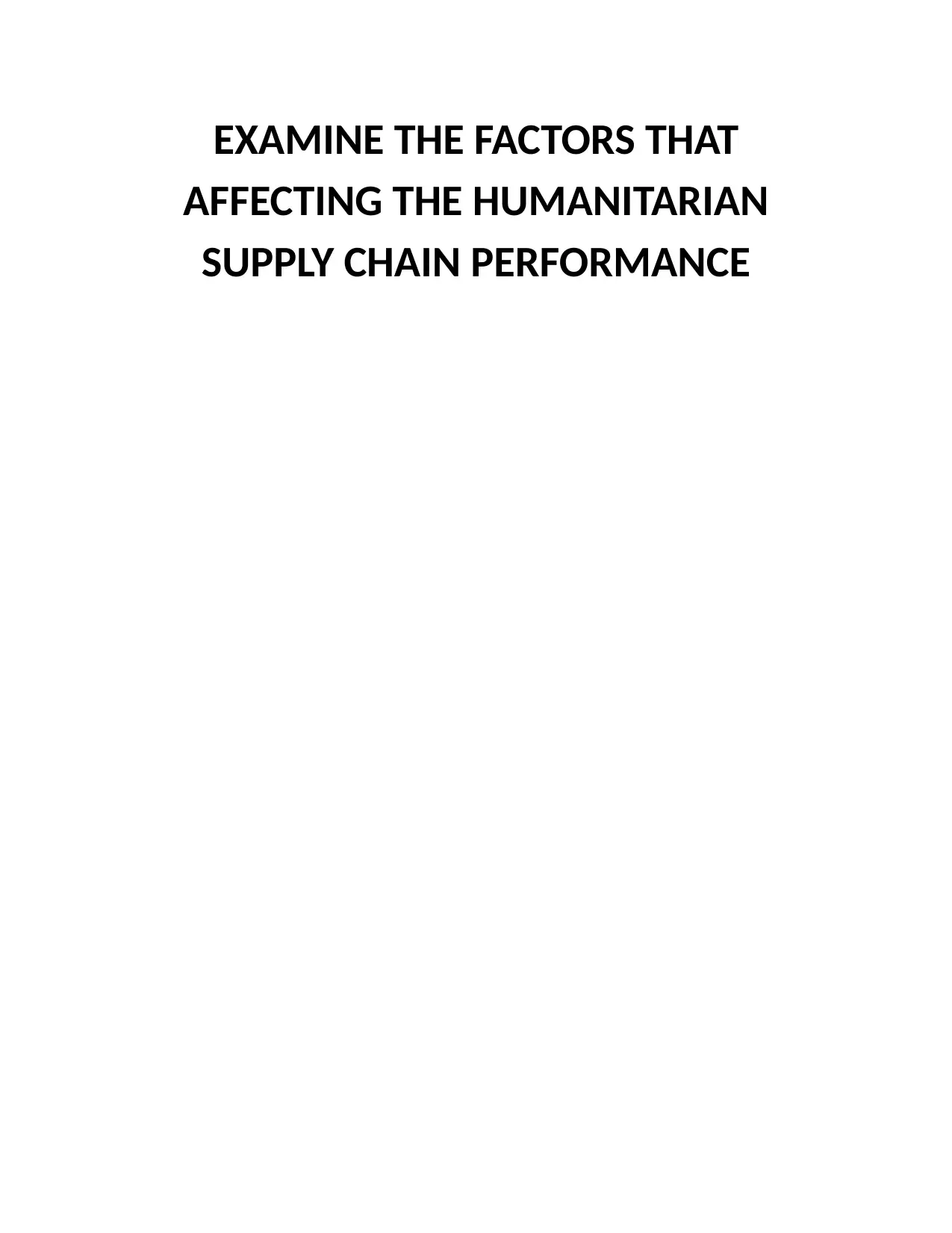
EXAMINE THE FACTORS THAT
AFFECTING THE HUMANITARIAN
SUPPLY CHAIN PERFORMANCE
AFFECTING THE HUMANITARIAN
SUPPLY CHAIN PERFORMANCE
Paraphrase This Document
Need a fresh take? Get an instant paraphrase of this document with our AI Paraphraser
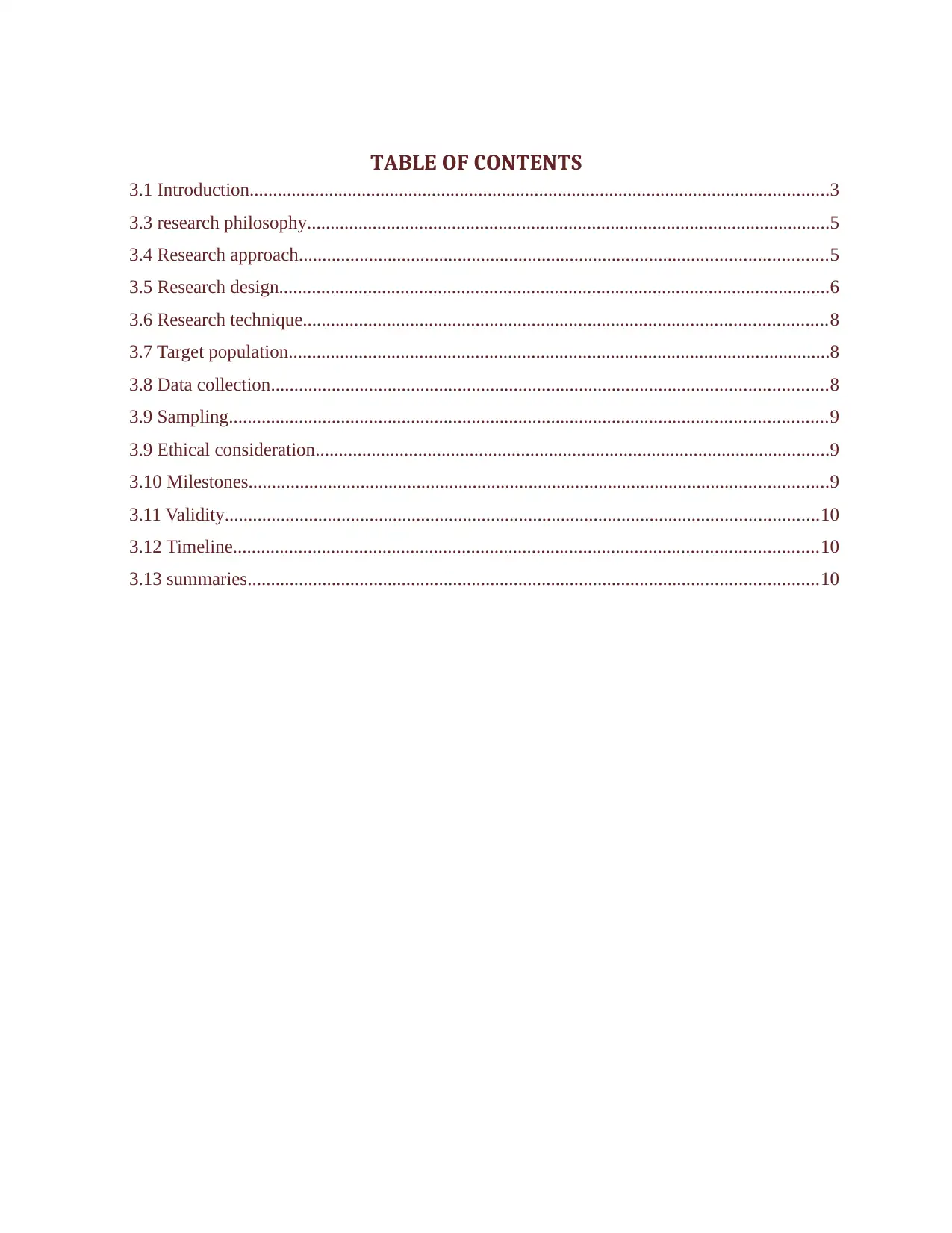
TABLE OF CONTENTS
3.1 Introduction............................................................................................................................3
3.3 research philosophy................................................................................................................5
3.4 Research approach.................................................................................................................5
3.5 Research design......................................................................................................................6
3.6 Research technique................................................................................................................8
3.7 Target population....................................................................................................................8
3.8 Data collection.......................................................................................................................8
3.9 Sampling................................................................................................................................9
3.9 Ethical consideration..............................................................................................................9
3.10 Milestones............................................................................................................................9
3.11 Validity...............................................................................................................................10
3.12 Timeline.............................................................................................................................10
3.13 summaries..........................................................................................................................10
3.1 Introduction............................................................................................................................3
3.3 research philosophy................................................................................................................5
3.4 Research approach.................................................................................................................5
3.5 Research design......................................................................................................................6
3.6 Research technique................................................................................................................8
3.7 Target population....................................................................................................................8
3.8 Data collection.......................................................................................................................8
3.9 Sampling................................................................................................................................9
3.9 Ethical consideration..............................................................................................................9
3.10 Milestones............................................................................................................................9
3.11 Validity...............................................................................................................................10
3.12 Timeline.............................................................................................................................10
3.13 summaries..........................................................................................................................10
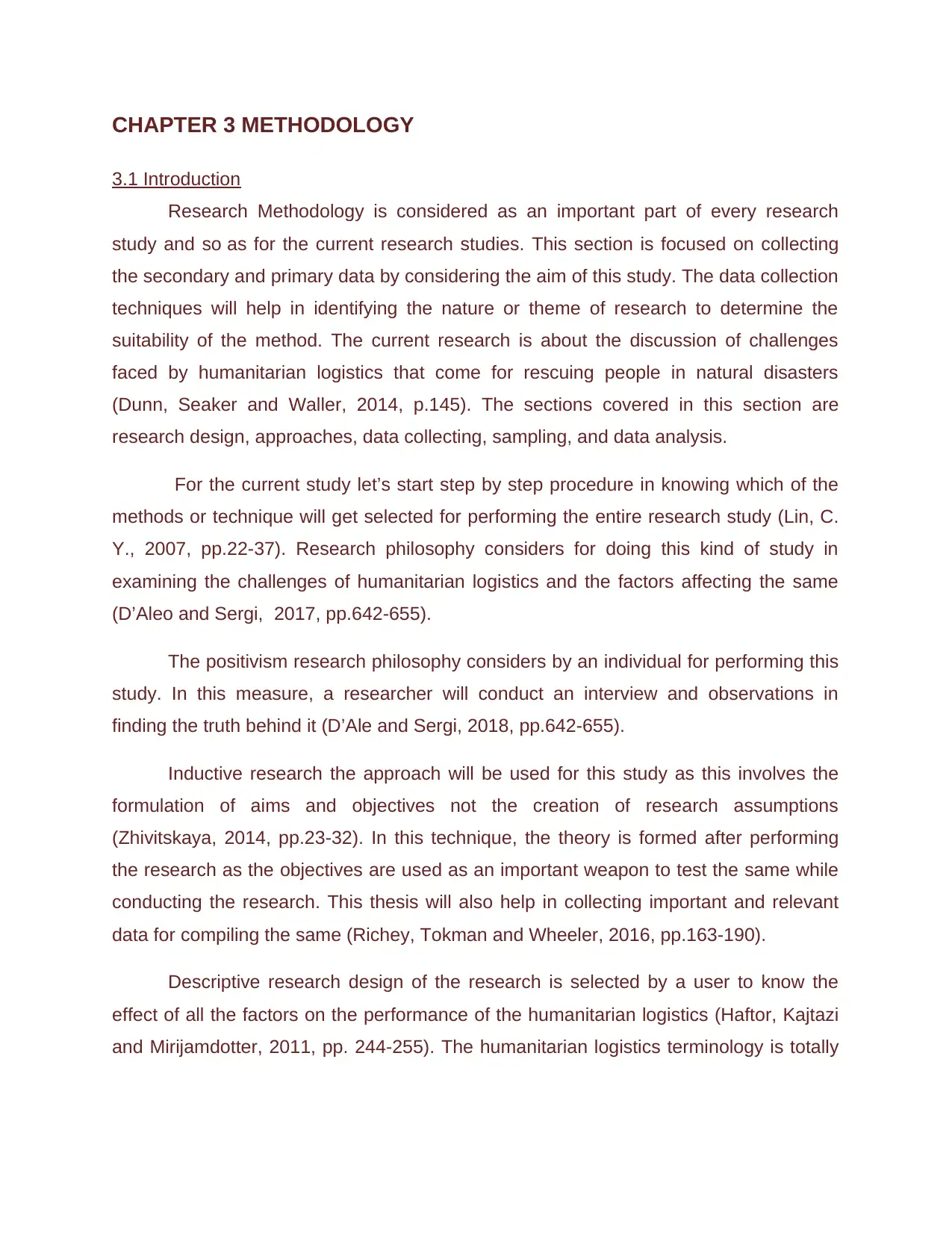
CHAPTER 3 METHODOLOGY
3.1 Introduction
Research Methodology is considered as an important part of every research
study and so as for the current research studies. This section is focused on collecting
the secondary and primary data by considering the aim of this study. The data collection
techniques will help in identifying the nature or theme of research to determine the
suitability of the method. The current research is about the discussion of challenges
faced by humanitarian logistics that come for rescuing people in natural disasters
(Dunn, Seaker and Waller, 2014, p.145). The sections covered in this section are
research design, approaches, data collecting, sampling, and data analysis.
For the current study let’s start step by step procedure in knowing which of the
methods or technique will get selected for performing the entire research study (Lin, C.
Y., 2007, pp.22-37). Research philosophy considers for doing this kind of study in
examining the challenges of humanitarian logistics and the factors affecting the same
(D’Aleo and Sergi, 2017, pp.642-655).
The positivism research philosophy considers by an individual for performing this
study. In this measure, a researcher will conduct an interview and observations in
finding the truth behind it (D’Ale and Sergi, 2018, pp.642-655).
Inductive research the approach will be used for this study as this involves the
formulation of aims and objectives not the creation of research assumptions
(Zhivitskaya, 2014, pp.23-32). In this technique, the theory is formed after performing
the research as the objectives are used as an important weapon to test the same while
conducting the research. This thesis will also help in collecting important and relevant
data for compiling the same (Richey, Tokman and Wheeler, 2016, pp.163-190).
Descriptive research design of the research is selected by a user to know the
effect of all the factors on the performance of the humanitarian logistics (Haftor, Kajtazi
and Mirijamdotter, 2011, pp. 244-255). The humanitarian logistics terminology is totally
3.1 Introduction
Research Methodology is considered as an important part of every research
study and so as for the current research studies. This section is focused on collecting
the secondary and primary data by considering the aim of this study. The data collection
techniques will help in identifying the nature or theme of research to determine the
suitability of the method. The current research is about the discussion of challenges
faced by humanitarian logistics that come for rescuing people in natural disasters
(Dunn, Seaker and Waller, 2014, p.145). The sections covered in this section are
research design, approaches, data collecting, sampling, and data analysis.
For the current study let’s start step by step procedure in knowing which of the
methods or technique will get selected for performing the entire research study (Lin, C.
Y., 2007, pp.22-37). Research philosophy considers for doing this kind of study in
examining the challenges of humanitarian logistics and the factors affecting the same
(D’Aleo and Sergi, 2017, pp.642-655).
The positivism research philosophy considers by an individual for performing this
study. In this measure, a researcher will conduct an interview and observations in
finding the truth behind it (D’Ale and Sergi, 2018, pp.642-655).
Inductive research the approach will be used for this study as this involves the
formulation of aims and objectives not the creation of research assumptions
(Zhivitskaya, 2014, pp.23-32). In this technique, the theory is formed after performing
the research as the objectives are used as an important weapon to test the same while
conducting the research. This thesis will also help in collecting important and relevant
data for compiling the same (Richey, Tokman and Wheeler, 2016, pp.163-190).
Descriptive research design of the research is selected by a user to know the
effect of all the factors on the performance of the humanitarian logistics (Haftor, Kajtazi
and Mirijamdotter, 2011, pp. 244-255). The humanitarian logistics terminology is totally
⊘ This is a preview!⊘
Do you want full access?
Subscribe today to unlock all pages.

Trusted by 1+ million students worldwide
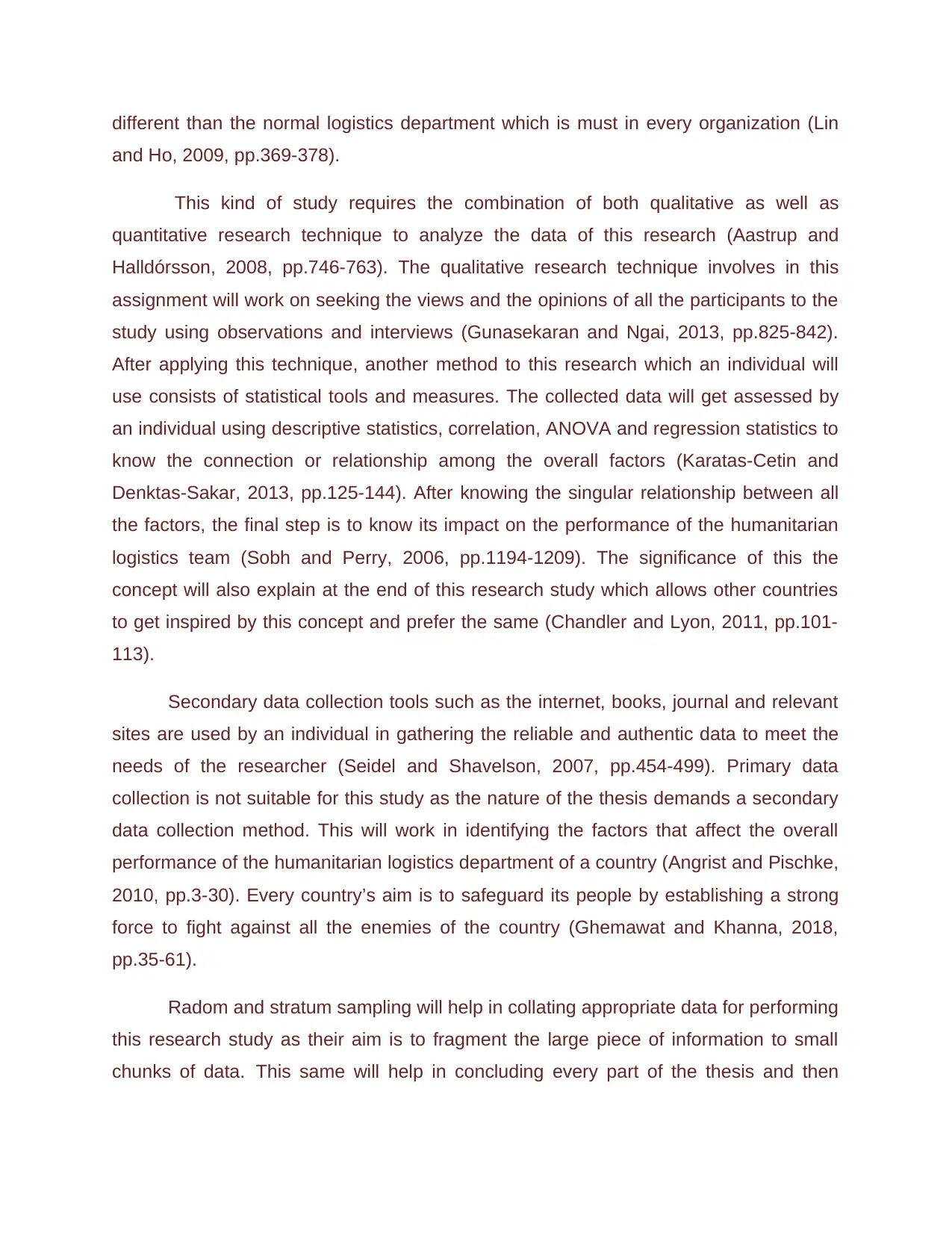
different than the normal logistics department which is must in every organization (Lin
and Ho, 2009, pp.369-378).
This kind of study requires the combination of both qualitative as well as
quantitative research technique to analyze the data of this research (Aastrup and
Halldórsson, 2008, pp.746-763). The qualitative research technique involves in this
assignment will work on seeking the views and the opinions of all the participants to the
study using observations and interviews (Gunasekaran and Ngai, 2013, pp.825-842).
After applying this technique, another method to this research which an individual will
use consists of statistical tools and measures. The collected data will get assessed by
an individual using descriptive statistics, correlation, ANOVA and regression statistics to
know the connection or relationship among the overall factors (Karatas-Cetin and
Denktas-Sakar, 2013, pp.125-144). After knowing the singular relationship between all
the factors, the final step is to know its impact on the performance of the humanitarian
logistics team (Sobh and Perry, 2006, pp.1194-1209). The significance of this the
concept will also explain at the end of this research study which allows other countries
to get inspired by this concept and prefer the same (Chandler and Lyon, 2011, pp.101-
113).
Secondary data collection tools such as the internet, books, journal and relevant
sites are used by an individual in gathering the reliable and authentic data to meet the
needs of the researcher (Seidel and Shavelson, 2007, pp.454-499). Primary data
collection is not suitable for this study as the nature of the thesis demands a secondary
data collection method. This will work in identifying the factors that affect the overall
performance of the humanitarian logistics department of a country (Angrist and Pischke,
2010, pp.3-30). Every country’s aim is to safeguard its people by establishing a strong
force to fight against all the enemies of the country (Ghemawat and Khanna, 2018,
pp.35-61).
Radom and stratum sampling will help in collating appropriate data for performing
this research study as their aim is to fragment the large piece of information to small
chunks of data. This same will help in concluding every part of the thesis and then
and Ho, 2009, pp.369-378).
This kind of study requires the combination of both qualitative as well as
quantitative research technique to analyze the data of this research (Aastrup and
Halldórsson, 2008, pp.746-763). The qualitative research technique involves in this
assignment will work on seeking the views and the opinions of all the participants to the
study using observations and interviews (Gunasekaran and Ngai, 2013, pp.825-842).
After applying this technique, another method to this research which an individual will
use consists of statistical tools and measures. The collected data will get assessed by
an individual using descriptive statistics, correlation, ANOVA and regression statistics to
know the connection or relationship among the overall factors (Karatas-Cetin and
Denktas-Sakar, 2013, pp.125-144). After knowing the singular relationship between all
the factors, the final step is to know its impact on the performance of the humanitarian
logistics team (Sobh and Perry, 2006, pp.1194-1209). The significance of this the
concept will also explain at the end of this research study which allows other countries
to get inspired by this concept and prefer the same (Chandler and Lyon, 2011, pp.101-
113).
Secondary data collection tools such as the internet, books, journal and relevant
sites are used by an individual in gathering the reliable and authentic data to meet the
needs of the researcher (Seidel and Shavelson, 2007, pp.454-499). Primary data
collection is not suitable for this study as the nature of the thesis demands a secondary
data collection method. This will work in identifying the factors that affect the overall
performance of the humanitarian logistics department of a country (Angrist and Pischke,
2010, pp.3-30). Every country’s aim is to safeguard its people by establishing a strong
force to fight against all the enemies of the country (Ghemawat and Khanna, 2018,
pp.35-61).
Radom and stratum sampling will help in collating appropriate data for performing
this research study as their aim is to fragment the large piece of information to small
chunks of data. This same will help in concluding every part of the thesis and then
Paraphrase This Document
Need a fresh take? Get an instant paraphrase of this document with our AI Paraphraser
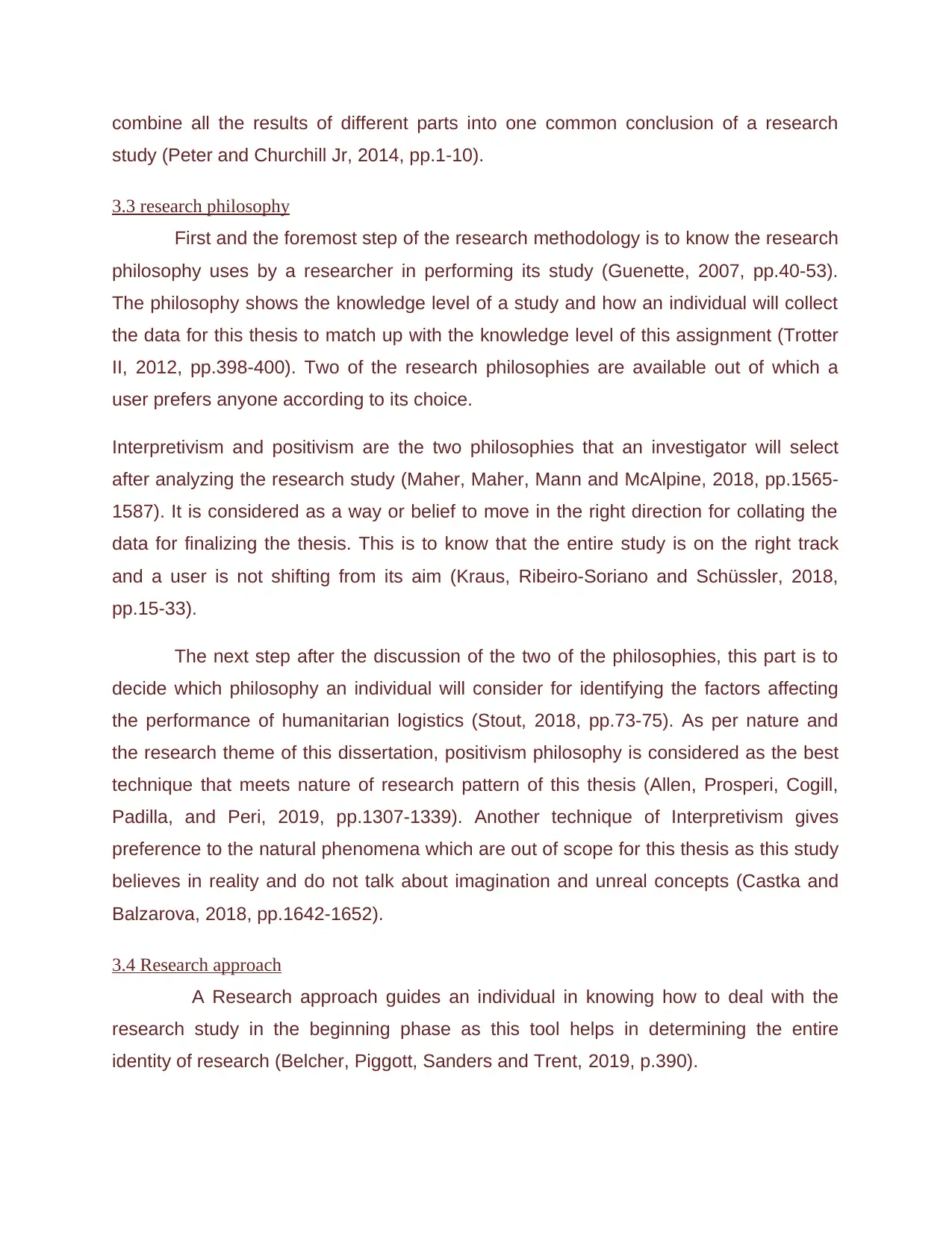
combine all the results of different parts into one common conclusion of a research
study (Peter and Churchill Jr, 2014, pp.1-10).
3.3 research philosophy
First and the foremost step of the research methodology is to know the research
philosophy uses by a researcher in performing its study (Guenette, 2007, pp.40-53).
The philosophy shows the knowledge level of a study and how an individual will collect
the data for this thesis to match up with the knowledge level of this assignment (Trotter
II, 2012, pp.398-400). Two of the research philosophies are available out of which a
user prefers anyone according to its choice.
Interpretivism and positivism are the two philosophies that an investigator will select
after analyzing the research study (Maher, Maher, Mann and McAlpine, 2018, pp.1565-
1587). It is considered as a way or belief to move in the right direction for collating the
data for finalizing the thesis. This is to know that the entire study is on the right track
and a user is not shifting from its aim (Kraus, Ribeiro-Soriano and Schüssler, 2018,
pp.15-33).
The next step after the discussion of the two of the philosophies, this part is to
decide which philosophy an individual will consider for identifying the factors affecting
the performance of humanitarian logistics (Stout, 2018, pp.73-75). As per nature and
the research theme of this dissertation, positivism philosophy is considered as the best
technique that meets nature of research pattern of this thesis (Allen, Prosperi, Cogill,
Padilla, and Peri, 2019, pp.1307-1339). Another technique of Interpretivism gives
preference to the natural phenomena which are out of scope for this thesis as this study
believes in reality and do not talk about imagination and unreal concepts (Castka and
Balzarova, 2018, pp.1642-1652).
3.4 Research approach
A Research approach guides an individual in knowing how to deal with the
research study in the beginning phase as this tool helps in determining the entire
identity of research (Belcher, Piggott, Sanders and Trent, 2019, p.390).
study (Peter and Churchill Jr, 2014, pp.1-10).
3.3 research philosophy
First and the foremost step of the research methodology is to know the research
philosophy uses by a researcher in performing its study (Guenette, 2007, pp.40-53).
The philosophy shows the knowledge level of a study and how an individual will collect
the data for this thesis to match up with the knowledge level of this assignment (Trotter
II, 2012, pp.398-400). Two of the research philosophies are available out of which a
user prefers anyone according to its choice.
Interpretivism and positivism are the two philosophies that an investigator will select
after analyzing the research study (Maher, Maher, Mann and McAlpine, 2018, pp.1565-
1587). It is considered as a way or belief to move in the right direction for collating the
data for finalizing the thesis. This is to know that the entire study is on the right track
and a user is not shifting from its aim (Kraus, Ribeiro-Soriano and Schüssler, 2018,
pp.15-33).
The next step after the discussion of the two of the philosophies, this part is to
decide which philosophy an individual will consider for identifying the factors affecting
the performance of humanitarian logistics (Stout, 2018, pp.73-75). As per nature and
the research theme of this dissertation, positivism philosophy is considered as the best
technique that meets nature of research pattern of this thesis (Allen, Prosperi, Cogill,
Padilla, and Peri, 2019, pp.1307-1339). Another technique of Interpretivism gives
preference to the natural phenomena which are out of scope for this thesis as this study
believes in reality and do not talk about imagination and unreal concepts (Castka and
Balzarova, 2018, pp.1642-1652).
3.4 Research approach
A Research approach guides an individual in knowing how to deal with the
research study in the beginning phase as this tool helps in determining the entire
identity of research (Belcher, Piggott, Sanders and Trent, 2019, p.390).
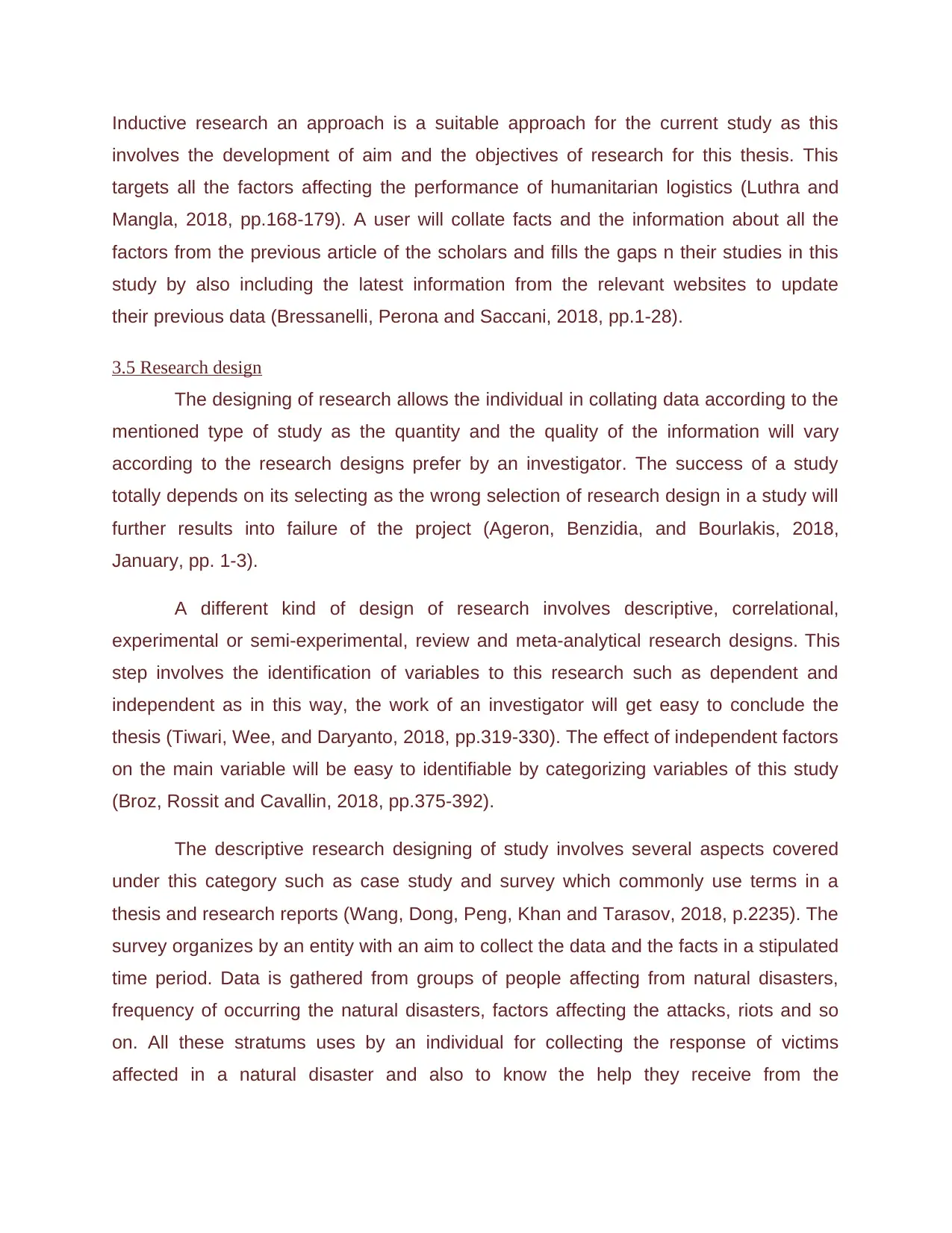
Inductive research an approach is a suitable approach for the current study as this
involves the development of aim and the objectives of research for this thesis. This
targets all the factors affecting the performance of humanitarian logistics (Luthra and
Mangla, 2018, pp.168-179). A user will collate facts and the information about all the
factors from the previous article of the scholars and fills the gaps n their studies in this
study by also including the latest information from the relevant websites to update
their previous data (Bressanelli, Perona and Saccani, 2018, pp.1-28).
3.5 Research design
The designing of research allows the individual in collating data according to the
mentioned type of study as the quantity and the quality of the information will vary
according to the research designs prefer by an investigator. The success of a study
totally depends on its selecting as the wrong selection of research design in a study will
further results into failure of the project (Ageron, Benzidia, and Bourlakis, 2018,
January, pp. 1-3).
A different kind of design of research involves descriptive, correlational,
experimental or semi-experimental, review and meta-analytical research designs. This
step involves the identification of variables to this research such as dependent and
independent as in this way, the work of an investigator will get easy to conclude the
thesis (Tiwari, Wee, and Daryanto, 2018, pp.319-330). The effect of independent factors
on the main variable will be easy to identifiable by categorizing variables of this study
(Broz, Rossit and Cavallin, 2018, pp.375-392).
The descriptive research designing of study involves several aspects covered
under this category such as case study and survey which commonly use terms in a
thesis and research reports (Wang, Dong, Peng, Khan and Tarasov, 2018, p.2235). The
survey organizes by an entity with an aim to collect the data and the facts in a stipulated
time period. Data is gathered from groups of people affecting from natural disasters,
frequency of occurring the natural disasters, factors affecting the attacks, riots and so
on. All these stratums uses by an individual for collecting the response of victims
affected in a natural disaster and also to know the help they receive from the
involves the development of aim and the objectives of research for this thesis. This
targets all the factors affecting the performance of humanitarian logistics (Luthra and
Mangla, 2018, pp.168-179). A user will collate facts and the information about all the
factors from the previous article of the scholars and fills the gaps n their studies in this
study by also including the latest information from the relevant websites to update
their previous data (Bressanelli, Perona and Saccani, 2018, pp.1-28).
3.5 Research design
The designing of research allows the individual in collating data according to the
mentioned type of study as the quantity and the quality of the information will vary
according to the research designs prefer by an investigator. The success of a study
totally depends on its selecting as the wrong selection of research design in a study will
further results into failure of the project (Ageron, Benzidia, and Bourlakis, 2018,
January, pp. 1-3).
A different kind of design of research involves descriptive, correlational,
experimental or semi-experimental, review and meta-analytical research designs. This
step involves the identification of variables to this research such as dependent and
independent as in this way, the work of an investigator will get easy to conclude the
thesis (Tiwari, Wee, and Daryanto, 2018, pp.319-330). The effect of independent factors
on the main variable will be easy to identifiable by categorizing variables of this study
(Broz, Rossit and Cavallin, 2018, pp.375-392).
The descriptive research designing of study involves several aspects covered
under this category such as case study and survey which commonly use terms in a
thesis and research reports (Wang, Dong, Peng, Khan and Tarasov, 2018, p.2235). The
survey organizes by an entity with an aim to collect the data and the facts in a stipulated
time period. Data is gathered from groups of people affecting from natural disasters,
frequency of occurring the natural disasters, factors affecting the attacks, riots and so
on. All these stratums uses by an individual for collecting the response of victims
affected in a natural disaster and also to know the help they receive from the
⊘ This is a preview!⊘
Do you want full access?
Subscribe today to unlock all pages.

Trusted by 1+ million students worldwide
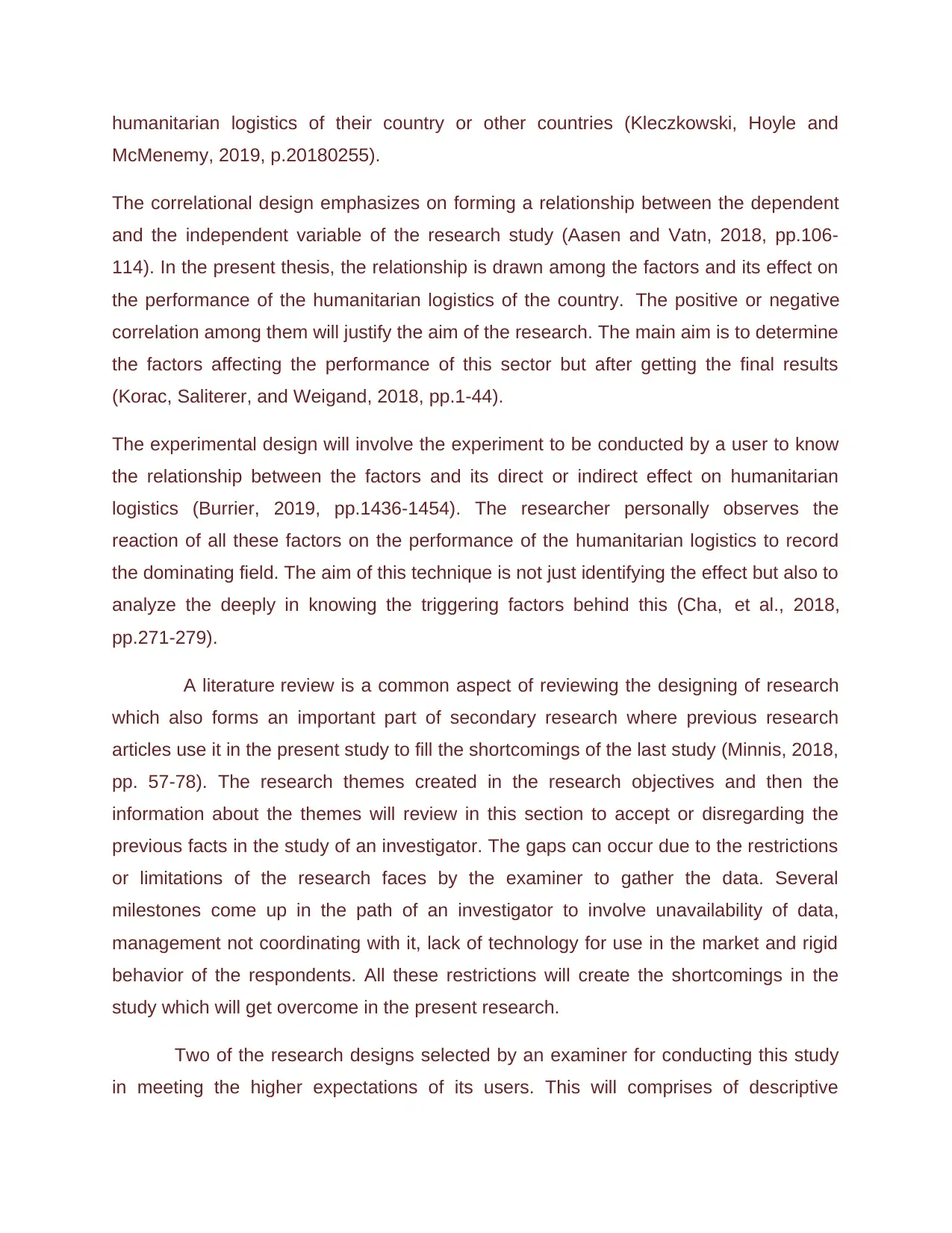
humanitarian logistics of their country or other countries (Kleczkowski, Hoyle and
McMenemy, 2019, p.20180255).
The correlational design emphasizes on forming a relationship between the dependent
and the independent variable of the research study (Aasen and Vatn, 2018, pp.106-
114). In the present thesis, the relationship is drawn among the factors and its effect on
the performance of the humanitarian logistics of the country. The positive or negative
correlation among them will justify the aim of the research. The main aim is to determine
the factors affecting the performance of this sector but after getting the final results
(Korac, Saliterer, and Weigand, 2018, pp.1-44).
The experimental design will involve the experiment to be conducted by a user to know
the relationship between the factors and its direct or indirect effect on humanitarian
logistics (Burrier, 2019, pp.1436-1454). The researcher personally observes the
reaction of all these factors on the performance of the humanitarian logistics to record
the dominating field. The aim of this technique is not just identifying the effect but also to
analyze the deeply in knowing the triggering factors behind this (Cha, et al., 2018,
pp.271-279).
A literature review is a common aspect of reviewing the designing of research
which also forms an important part of secondary research where previous research
articles use it in the present study to fill the shortcomings of the last study (Minnis, 2018,
pp. 57-78). The research themes created in the research objectives and then the
information about the themes will review in this section to accept or disregarding the
previous facts in the study of an investigator. The gaps can occur due to the restrictions
or limitations of the research faces by the examiner to gather the data. Several
milestones come up in the path of an investigator to involve unavailability of data,
management not coordinating with it, lack of technology for use in the market and rigid
behavior of the respondents. All these restrictions will create the shortcomings in the
study which will get overcome in the present research.
Two of the research designs selected by an examiner for conducting this study
in meeting the higher expectations of its users. This will comprises of descriptive
McMenemy, 2019, p.20180255).
The correlational design emphasizes on forming a relationship between the dependent
and the independent variable of the research study (Aasen and Vatn, 2018, pp.106-
114). In the present thesis, the relationship is drawn among the factors and its effect on
the performance of the humanitarian logistics of the country. The positive or negative
correlation among them will justify the aim of the research. The main aim is to determine
the factors affecting the performance of this sector but after getting the final results
(Korac, Saliterer, and Weigand, 2018, pp.1-44).
The experimental design will involve the experiment to be conducted by a user to know
the relationship between the factors and its direct or indirect effect on humanitarian
logistics (Burrier, 2019, pp.1436-1454). The researcher personally observes the
reaction of all these factors on the performance of the humanitarian logistics to record
the dominating field. The aim of this technique is not just identifying the effect but also to
analyze the deeply in knowing the triggering factors behind this (Cha, et al., 2018,
pp.271-279).
A literature review is a common aspect of reviewing the designing of research
which also forms an important part of secondary research where previous research
articles use it in the present study to fill the shortcomings of the last study (Minnis, 2018,
pp. 57-78). The research themes created in the research objectives and then the
information about the themes will review in this section to accept or disregarding the
previous facts in the study of an investigator. The gaps can occur due to the restrictions
or limitations of the research faces by the examiner to gather the data. Several
milestones come up in the path of an investigator to involve unavailability of data,
management not coordinating with it, lack of technology for use in the market and rigid
behavior of the respondents. All these restrictions will create the shortcomings in the
study which will get overcome in the present research.
Two of the research designs selected by an examiner for conducting this study
in meeting the higher expectations of its users. This will comprises of descriptive
Paraphrase This Document
Need a fresh take? Get an instant paraphrase of this document with our AI Paraphraser
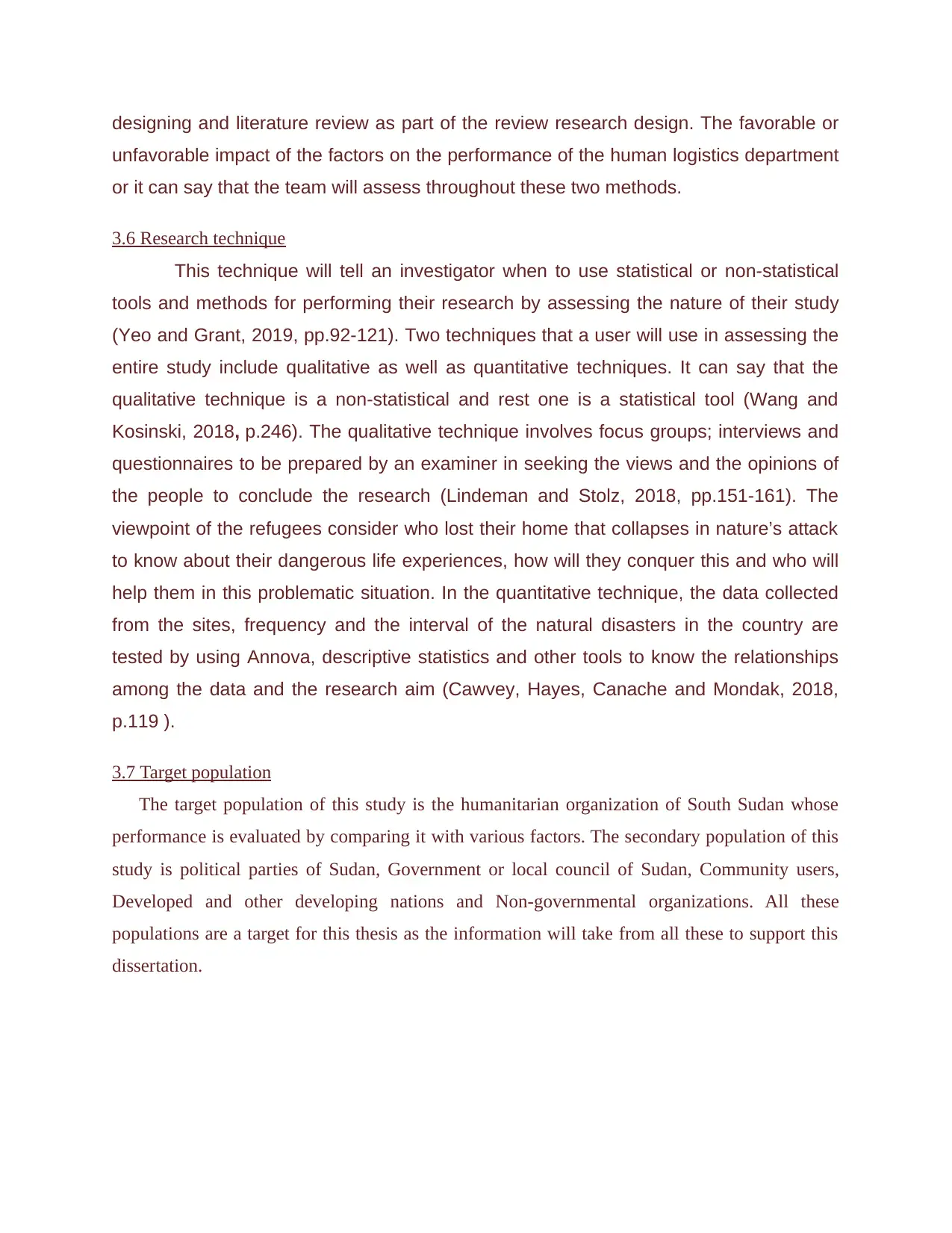
designing and literature review as part of the review research design. The favorable or
unfavorable impact of the factors on the performance of the human logistics department
or it can say that the team will assess throughout these two methods.
3.6 Research technique
This technique will tell an investigator when to use statistical or non-statistical
tools and methods for performing their research by assessing the nature of their study
(Yeo and Grant, 2019, pp.92-121). Two techniques that a user will use in assessing the
entire study include qualitative as well as quantitative techniques. It can say that the
qualitative technique is a non-statistical and rest one is a statistical tool (Wang and
Kosinski, 2018, p.246). The qualitative technique involves focus groups; interviews and
questionnaires to be prepared by an examiner in seeking the views and the opinions of
the people to conclude the research (Lindeman and Stolz, 2018, pp.151-161). The
viewpoint of the refugees consider who lost their home that collapses in nature’s attack
to know about their dangerous life experiences, how will they conquer this and who will
help them in this problematic situation. In the quantitative technique, the data collected
from the sites, frequency and the interval of the natural disasters in the country are
tested by using Annova, descriptive statistics and other tools to know the relationships
among the data and the research aim (Cawvey, Hayes, Canache and Mondak, 2018,
p.119 ).
3.7 Target population
The target population of this study is the humanitarian organization of South Sudan whose
performance is evaluated by comparing it with various factors. The secondary population of this
study is political parties of Sudan, Government or local council of Sudan, Community users,
Developed and other developing nations and Non-governmental organizations. All these
populations are a target for this thesis as the information will take from all these to support this
dissertation.
unfavorable impact of the factors on the performance of the human logistics department
or it can say that the team will assess throughout these two methods.
3.6 Research technique
This technique will tell an investigator when to use statistical or non-statistical
tools and methods for performing their research by assessing the nature of their study
(Yeo and Grant, 2019, pp.92-121). Two techniques that a user will use in assessing the
entire study include qualitative as well as quantitative techniques. It can say that the
qualitative technique is a non-statistical and rest one is a statistical tool (Wang and
Kosinski, 2018, p.246). The qualitative technique involves focus groups; interviews and
questionnaires to be prepared by an examiner in seeking the views and the opinions of
the people to conclude the research (Lindeman and Stolz, 2018, pp.151-161). The
viewpoint of the refugees consider who lost their home that collapses in nature’s attack
to know about their dangerous life experiences, how will they conquer this and who will
help them in this problematic situation. In the quantitative technique, the data collected
from the sites, frequency and the interval of the natural disasters in the country are
tested by using Annova, descriptive statistics and other tools to know the relationships
among the data and the research aim (Cawvey, Hayes, Canache and Mondak, 2018,
p.119 ).
3.7 Target population
The target population of this study is the humanitarian organization of South Sudan whose
performance is evaluated by comparing it with various factors. The secondary population of this
study is political parties of Sudan, Government or local council of Sudan, Community users,
Developed and other developing nations and Non-governmental organizations. All these
populations are a target for this thesis as the information will take from all these to support this
dissertation.
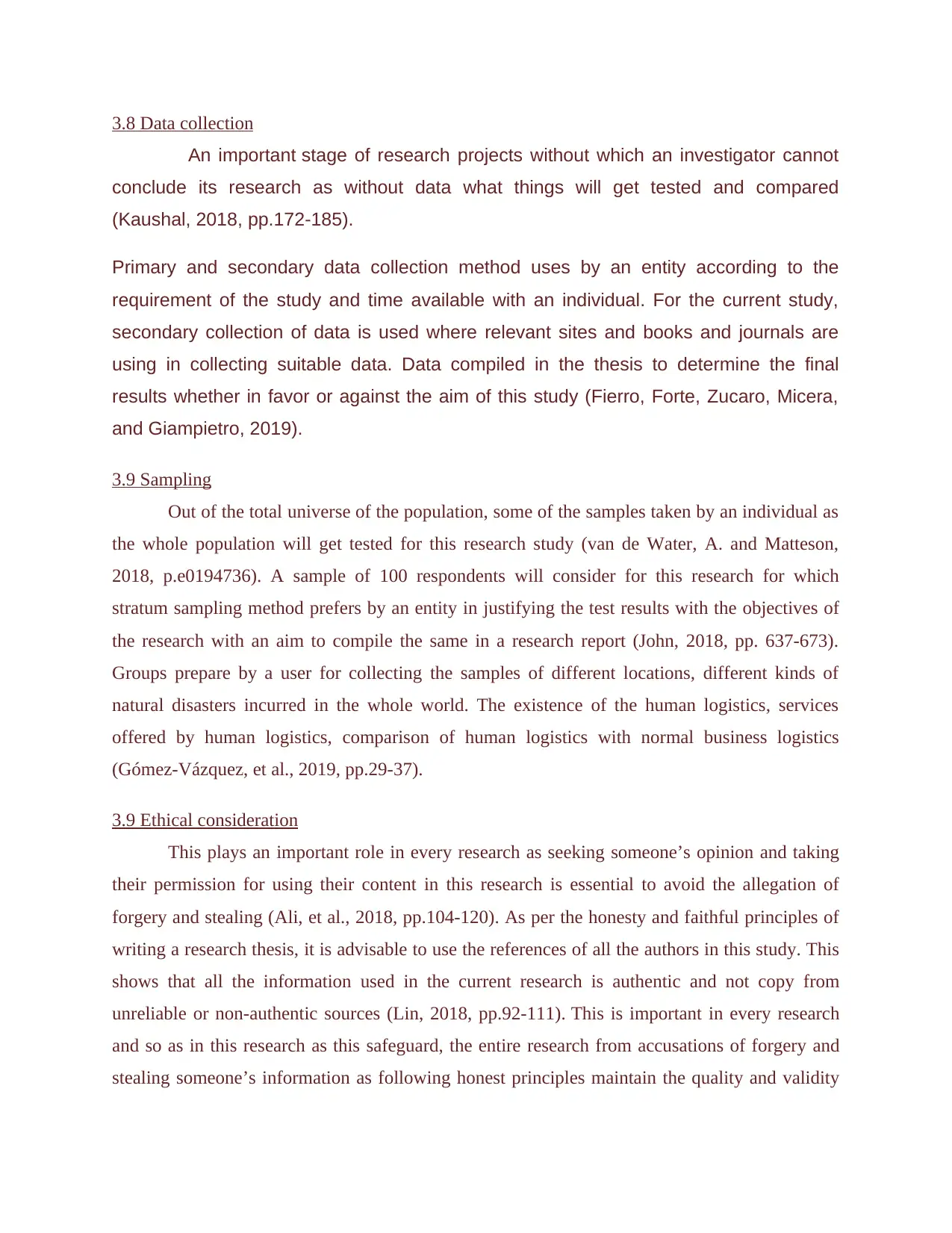
3.8 Data collection
An important stage of research projects without which an investigator cannot
conclude its research as without data what things will get tested and compared
(Kaushal, 2018, pp.172-185).
Primary and secondary data collection method uses by an entity according to the
requirement of the study and time available with an individual. For the current study,
secondary collection of data is used where relevant sites and books and journals are
using in collecting suitable data. Data compiled in the thesis to determine the final
results whether in favor or against the aim of this study (Fierro, Forte, Zucaro, Micera,
and Giampietro, 2019).
3.9 Sampling
Out of the total universe of the population, some of the samples taken by an individual as
the whole population will get tested for this research study (van de Water, A. and Matteson,
2018, p.e0194736). A sample of 100 respondents will consider for this research for which
stratum sampling method prefers by an entity in justifying the test results with the objectives of
the research with an aim to compile the same in a research report (John, 2018, pp. 637-673).
Groups prepare by a user for collecting the samples of different locations, different kinds of
natural disasters incurred in the whole world. The existence of the human logistics, services
offered by human logistics, comparison of human logistics with normal business logistics
(Gómez-Vázquez, et al., 2019, pp.29-37).
3.9 Ethical consideration
This plays an important role in every research as seeking someone’s opinion and taking
their permission for using their content in this research is essential to avoid the allegation of
forgery and stealing (Ali, et al., 2018, pp.104-120). As per the honesty and faithful principles of
writing a research thesis, it is advisable to use the references of all the authors in this study. This
shows that all the information used in the current research is authentic and not copy from
unreliable or non-authentic sources (Lin, 2018, pp.92-111). This is important in every research
and so as in this research as this safeguard, the entire research from accusations of forgery and
stealing someone’s information as following honest principles maintain the quality and validity
An important stage of research projects without which an investigator cannot
conclude its research as without data what things will get tested and compared
(Kaushal, 2018, pp.172-185).
Primary and secondary data collection method uses by an entity according to the
requirement of the study and time available with an individual. For the current study,
secondary collection of data is used where relevant sites and books and journals are
using in collecting suitable data. Data compiled in the thesis to determine the final
results whether in favor or against the aim of this study (Fierro, Forte, Zucaro, Micera,
and Giampietro, 2019).
3.9 Sampling
Out of the total universe of the population, some of the samples taken by an individual as
the whole population will get tested for this research study (van de Water, A. and Matteson,
2018, p.e0194736). A sample of 100 respondents will consider for this research for which
stratum sampling method prefers by an entity in justifying the test results with the objectives of
the research with an aim to compile the same in a research report (John, 2018, pp. 637-673).
Groups prepare by a user for collecting the samples of different locations, different kinds of
natural disasters incurred in the whole world. The existence of the human logistics, services
offered by human logistics, comparison of human logistics with normal business logistics
(Gómez-Vázquez, et al., 2019, pp.29-37).
3.9 Ethical consideration
This plays an important role in every research as seeking someone’s opinion and taking
their permission for using their content in this research is essential to avoid the allegation of
forgery and stealing (Ali, et al., 2018, pp.104-120). As per the honesty and faithful principles of
writing a research thesis, it is advisable to use the references of all the authors in this study. This
shows that all the information used in the current research is authentic and not copy from
unreliable or non-authentic sources (Lin, 2018, pp.92-111). This is important in every research
and so as in this research as this safeguard, the entire research from accusations of forgery and
stealing someone’s information as following honest principles maintain the quality and validity
⊘ This is a preview!⊘
Do you want full access?
Subscribe today to unlock all pages.

Trusted by 1+ million students worldwide
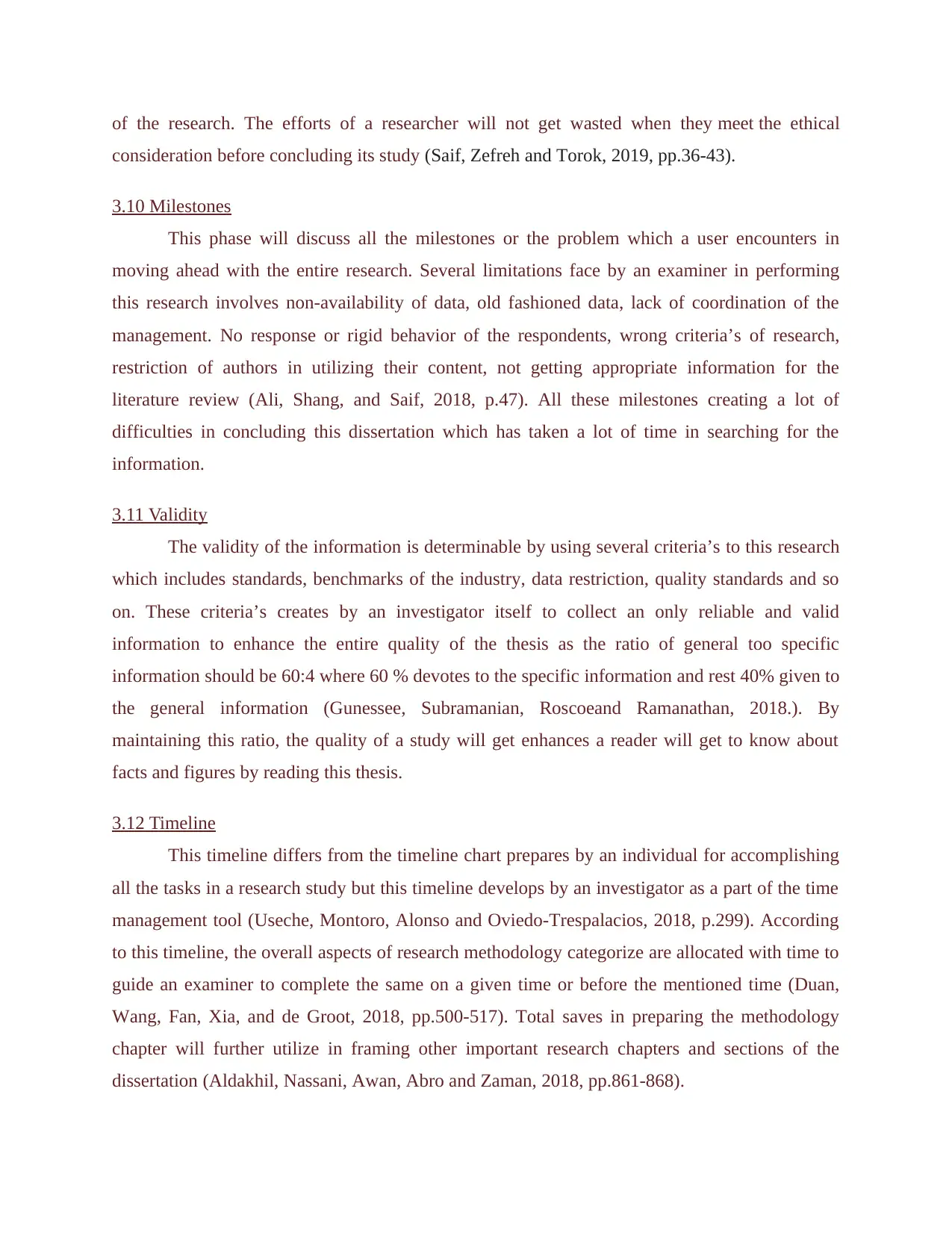
of the research. The efforts of a researcher will not get wasted when they meet the ethical
consideration before concluding its study (Saif, Zefreh and Torok, 2019, pp.36-43).
3.10 Milestones
This phase will discuss all the milestones or the problem which a user encounters in
moving ahead with the entire research. Several limitations face by an examiner in performing
this research involves non-availability of data, old fashioned data, lack of coordination of the
management. No response or rigid behavior of the respondents, wrong criteria’s of research,
restriction of authors in utilizing their content, not getting appropriate information for the
literature review (Ali, Shang, and Saif, 2018, p.47). All these milestones creating a lot of
difficulties in concluding this dissertation which has taken a lot of time in searching for the
information.
3.11 Validity
The validity of the information is determinable by using several criteria’s to this research
which includes standards, benchmarks of the industry, data restriction, quality standards and so
on. These criteria’s creates by an investigator itself to collect an only reliable and valid
information to enhance the entire quality of the thesis as the ratio of general too specific
information should be 60:4 where 60 % devotes to the specific information and rest 40% given to
the general information (Gunessee, Subramanian, Roscoeand Ramanathan, 2018.). By
maintaining this ratio, the quality of a study will get enhances a reader will get to know about
facts and figures by reading this thesis.
3.12 Timeline
This timeline differs from the timeline chart prepares by an individual for accomplishing
all the tasks in a research study but this timeline develops by an investigator as a part of the time
management tool (Useche, Montoro, Alonso and Oviedo-Trespalacios, 2018, p.299). According
to this timeline, the overall aspects of research methodology categorize are allocated with time to
guide an examiner to complete the same on a given time or before the mentioned time (Duan,
Wang, Fan, Xia, and de Groot, 2018, pp.500-517). Total saves in preparing the methodology
chapter will further utilize in framing other important research chapters and sections of the
dissertation (Aldakhil, Nassani, Awan, Abro and Zaman, 2018, pp.861-868).
consideration before concluding its study (Saif, Zefreh and Torok, 2019, pp.36-43).
3.10 Milestones
This phase will discuss all the milestones or the problem which a user encounters in
moving ahead with the entire research. Several limitations face by an examiner in performing
this research involves non-availability of data, old fashioned data, lack of coordination of the
management. No response or rigid behavior of the respondents, wrong criteria’s of research,
restriction of authors in utilizing their content, not getting appropriate information for the
literature review (Ali, Shang, and Saif, 2018, p.47). All these milestones creating a lot of
difficulties in concluding this dissertation which has taken a lot of time in searching for the
information.
3.11 Validity
The validity of the information is determinable by using several criteria’s to this research
which includes standards, benchmarks of the industry, data restriction, quality standards and so
on. These criteria’s creates by an investigator itself to collect an only reliable and valid
information to enhance the entire quality of the thesis as the ratio of general too specific
information should be 60:4 where 60 % devotes to the specific information and rest 40% given to
the general information (Gunessee, Subramanian, Roscoeand Ramanathan, 2018.). By
maintaining this ratio, the quality of a study will get enhances a reader will get to know about
facts and figures by reading this thesis.
3.12 Timeline
This timeline differs from the timeline chart prepares by an individual for accomplishing
all the tasks in a research study but this timeline develops by an investigator as a part of the time
management tool (Useche, Montoro, Alonso and Oviedo-Trespalacios, 2018, p.299). According
to this timeline, the overall aspects of research methodology categorize are allocated with time to
guide an examiner to complete the same on a given time or before the mentioned time (Duan,
Wang, Fan, Xia, and de Groot, 2018, pp.500-517). Total saves in preparing the methodology
chapter will further utilize in framing other important research chapters and sections of the
dissertation (Aldakhil, Nassani, Awan, Abro and Zaman, 2018, pp.861-868).
Paraphrase This Document
Need a fresh take? Get an instant paraphrase of this document with our AI Paraphraser

3.13 summaries
This includes the crux of the overall research methodology section that what experiences an
investigator witnessed while creating this chapter. An investigator witnessed ways to enhance the
quality of the research methodology by using quality oriented research methods. Tools to steal
the attention of all the users towards this research with an aim to get the positive results of the
study (Ranieri, Digiesi, Silvestri and Roccotelli, 2018, p.782). The main aim of conducting a
dissertation is to get detailed knowledge about patience, time management, and team
coordination (Carlucci, Cirà, Ioppolo, Massari and Siviero, 2018, pp.60-69).
This includes the crux of the overall research methodology section that what experiences an
investigator witnessed while creating this chapter. An investigator witnessed ways to enhance the
quality of the research methodology by using quality oriented research methods. Tools to steal
the attention of all the users towards this research with an aim to get the positive results of the
study (Ranieri, Digiesi, Silvestri and Roccotelli, 2018, p.782). The main aim of conducting a
dissertation is to get detailed knowledge about patience, time management, and team
coordination (Carlucci, Cirà, Ioppolo, Massari and Siviero, 2018, pp.60-69).
1 out of 11
Related Documents
Your All-in-One AI-Powered Toolkit for Academic Success.
+13062052269
info@desklib.com
Available 24*7 on WhatsApp / Email
![[object Object]](/_next/static/media/star-bottom.7253800d.svg)
Unlock your academic potential
Copyright © 2020–2025 A2Z Services. All Rights Reserved. Developed and managed by ZUCOL.





